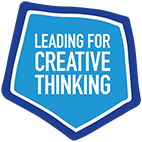Leadership to develop environments for creative thinking
A decade ago researchers reviewed the evidence; are their findings about learning environments still true today?
Davies, D., Jindal-Snape, D., Collier, C., Digby, R., Hay, P., & Howe, A. (2013). Creative Learning Environments in Education - A Systematic Literature Review. Thinking Skills and Creativity, 8, 80-91.
Read the whole article here.
Summary
In 2011 a team of researchers were commissioned by Learning and Teaching Scotland to research on environments in school which are conducive to the cultivation of creativity. The researchers found comparatively few studies but nevertheless were able to suggest that the following factors are important in supporting creative skills development in children and young people:
- Use of space. There is reasonable evidence that flexible us of space enables pupils to develop their imagination in a range of settings and that an important feature of the visual environment is displays of work in progress.
- Availability of materials. There is strong evidence that providing a wide range of appropriate materials, tools and other resources can stimulate creativity. (Access to new educational technologies in a largely pre social media world were very limited then!)
- Working outside the classroom. There is reasonable evidence across several studies that taking pupils out of the classroom and working in an outdoor environment for part of their time in school can foster their creative development. Once outdoors, time and space are seen as more owned by pupils; inside work tends to be individually focused, whereas outside learning activities are more likely to involve collaboration.
- The pedagogical environment. ‘Playful’ or ‘games-bases’ approaches with a degree of learner autonomy are associated with the development of creativity. In the classroom there is reasonable evidence that, to stimulate creative responses from pupils, activities need an element of novelty. While freedom of expression is important, so too are structures which enable pupils to take risks, to think creatively and critically, and to question the opinions of others.
- Play. The role of play in cultivating creativity is well-documented.
- Use of time. There is reasonable evidence that creativity is best served through flexible use of time. Young children benefit from sufficient time for immersion in an activity in order to realise creative outcomes. At secondary level, for example with art and design, it is helpful when resources are available outside timetabled hours and when there is a variety of extracurricular opportunities activities available outside the normal constraints of the classroom.
- Teacher-pupil relationships. Dialogue and mutual respect are important. The ability of teachers to act spontaneously and change plans demonstrates through role modelling their commitment to creative learning. An emphasis on intentionally teaching pupils the process of using dialogue promotes mutual understanding and the development of ideas.
- Use of environments beyond school. There is reasonable evidence that taking children and young people out of school to learn in environments such as museums and galleries enhances their creative skills. There is strong evidence that involvement with outside agencies such as the local business community, sports and arts bodies, and other community organisations can significantly contribute to a creative learning environment.

The review recommended that:
- Their findings should be shared with schools.
- It is important to distinguish between the roles of ‘critical events’ (projects, themed weeks, work with outside agencies) and ongoing good classroom practice in the establishment of creative environments.
- Schools need guidance on how to establish and maintain partnerships with external organisations to enhance the creative environment and facilitate professional learning and ensure a long-term impact on pedagogy.
- Teachers need to be supported to focus upon the processes of creative skills development rather than outcomes, as evidence suggests that external pressures in terms of achievement or exhibition deadlines can tend to distort creative relationships in the classroom and hence disturb creative learning environments.
- Teachers need guidance on the flexible use of physical environments including the outdoors to best support children and young people’s creativity.
- Teachers’ awareness of the importance of modelling creative attitudes and behaviour needs to be raised.
- Teachers should be encouraged to provide pupils with more control of their learning and opportunities to work at their own pace and with peers.
- Schools need professional learning for teachers to understand their preconceptions of creativity, stimulate dialogue around models of creativity, teaching and learning, and provide them with opportunities to develop their own creativity while undertaking reflective professional enquiry.
Reflecting together
1. Do the 8 factors identified by the researchers resonate with you and your experiences in schools in developing creative environments?
2. Do you agree with the recommendations made by the research team? To what extent do you think some of these have happened / are beginning to happen over the last decade?
3. How would you rate the quality of your own learning environments in terms of cultivating creativity?
4. What do you think the role of school leaders is in developing, sustaining and using creative learning environments in and beyond school?
